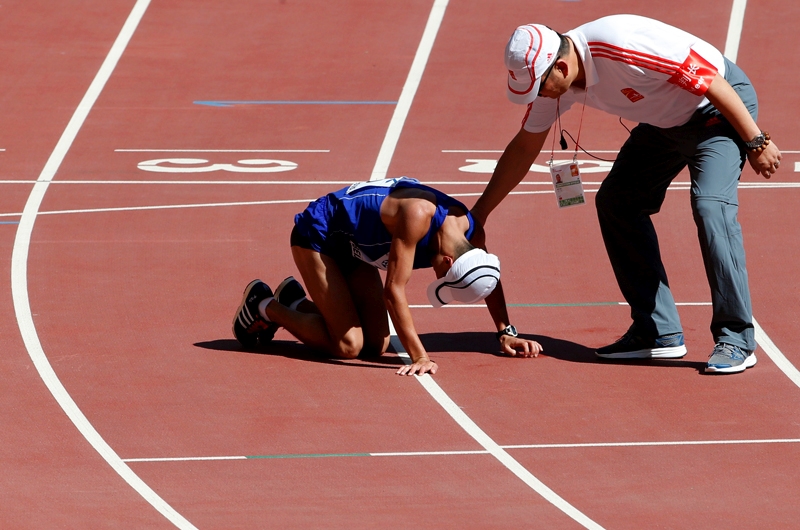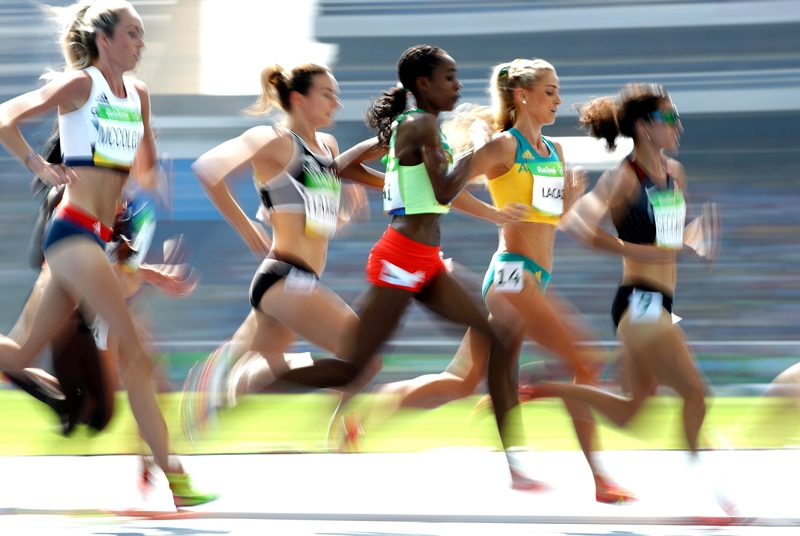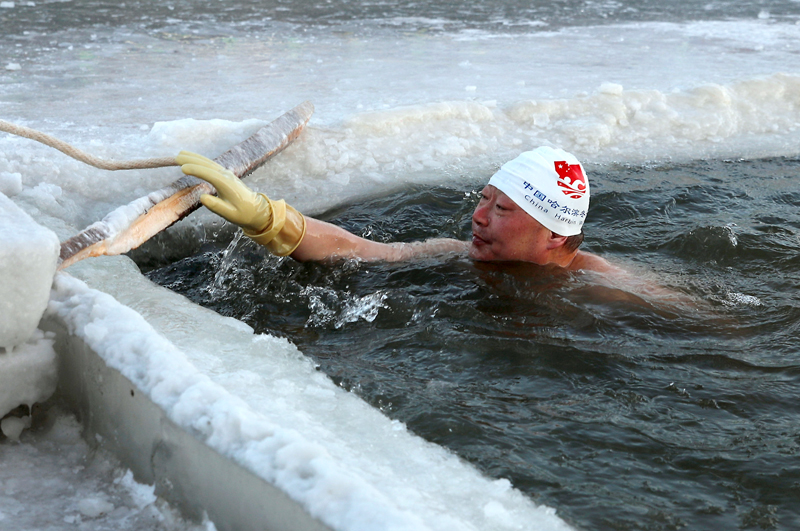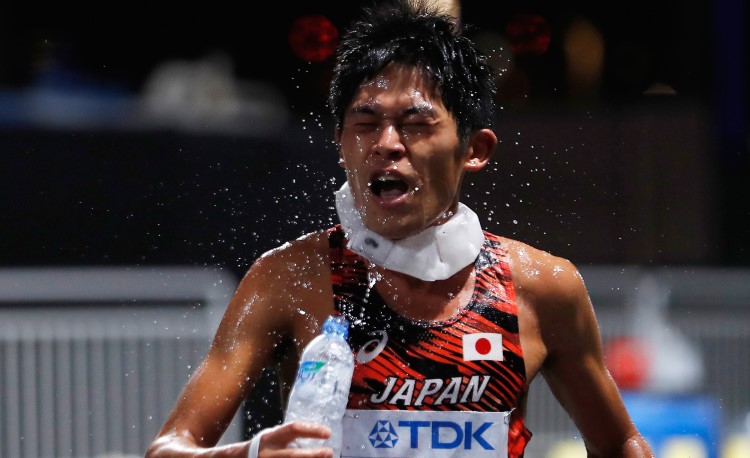Marathon pacing: beating the heat
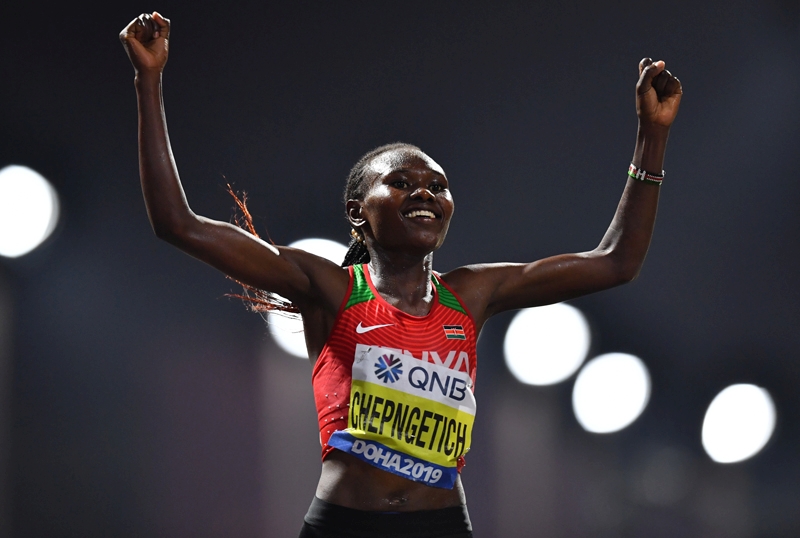
Kenya's Ruth Chepngetich celebrates winning the Doha 2019 Women's Marathon
How should marathon runners adjust their pacing in hot and humid conditions? SPB looks at new research from the Doha Marathon for answers
Qatar is not a country that is familiar to most of us, but when soccer’s World Cup championships kick off in Doha (the capitol) later this year, you’ll no doubt hear a lot more about it, and in particular, the climate. Located at just 25 degrees north of the equator and with the continental mass of the Saudi Arabian peninsula and Saharan Africa to its west, Qatar is a hot country – very hot! Climatology data shows that Qatar’s summers are long, sweltering, muggy and arid. The ‘hot’ season lasts from mid May to the end of September, with an average daily high temperature between 38C and 42C (100F to 107F). Even at night, the very ‘coolest’ temperature you can expect is around 27C to 30C (81F to 86F). Add in high humidity levels and you have a very challenging environment, especially if you like cool weather!Hot marathon
Needless to say, with such high levels of heat, performing in any kind of athletic competition during Qatar’s hot season is a very arduous affair, which explains why the 2022 World Cup tournament was moved to late November/early December. However, in September 2019, the World Athletics Championships took place in Qatar, which presented the athletes participating in the longer events with a real test of their capacity to perform in the heat. And nowhere was this test more challenging than in the men’s and women’s marathon events.Due to the very hot conditions and considerations for the runners’ welfare, the organizers decided to start the event at midnight, making it the first midnight marathon in the history of the World Championships. Even so, the temperature during the race hovered around 30-32C (86-90F), with exceptionally high humidity of over 80%, explaining why the IAAF added extra water stations and medical staff along the route, as well as extra ice baths at the finish. Although bringing together the world’s most elite marathon runners, these brutally hot conditions still took their toll; in the women’s race for example, only 40 of the 68 entrants managed to finish the race – an incredible dropout rate of 41%!
Times were also markedly slower; in the men’s race, Lelisa Desisa’s winning time was 2hrs 10mins 40secs – a time that wouldn’t have been quick enough to be a world champion even as far back as 1967, when Derek Clayton was running sub 2hrs 10mins. In the women’s race, which was won by Ruth Chepngetich (pictured above) of Kenya in 2hrs 32mins 43secs, this turned out to be the slowest ever winning time at the World Championships, not quite bettering Greta Waitz’s set in the New York Marathon back in 1978! We can see from these times that the heat clearly took its toll.
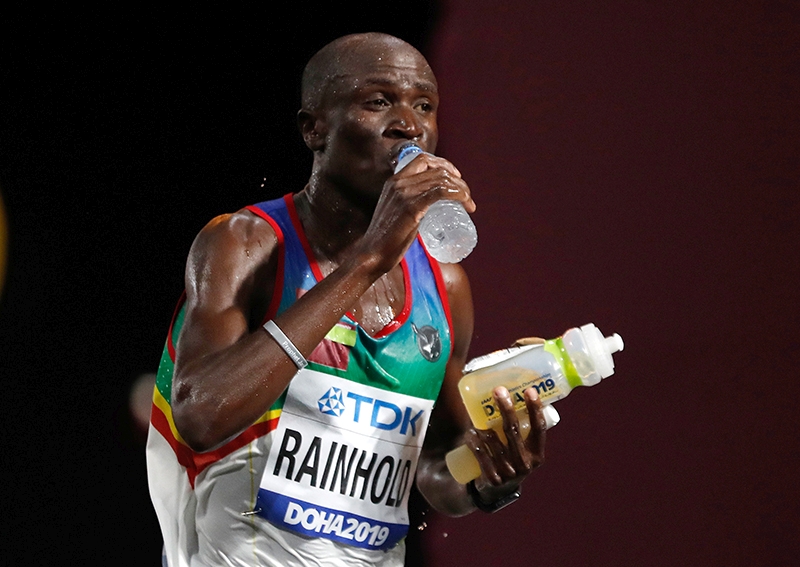
Namibia's Tomas Hilifa Rainhold in action in the 2019 Doha Men's Marathon.
Learning from the heat
The extreme conditions in the Doha marathon obviously worked against the athletes, producing much slower times and plenty of non finishers. However, for researchers interested in hot-weather endurance performance, they provided a very interesting batch of data to explore. In particular, these conditions provided the ideal scenario to determine if any common factors separated the medal winners from the rest of the athletes. And this is exactly what a team of researchers from the UK have just done in a newly published study published in the International Journal of Sports Physiology and Performance(1).Given that heat tolerance is quite an individual characteristic, and one that can only be trained (through acclimation – see this article) to a limited degree, the researchers instead decided to primarily focus on one variable that could be easily altered by the runners – pacing. In the study, the researchers analyzed data from the 40 finishers in the Doha 2019 women's World Championship marathon, and explored whether extreme heat or suboptimal pacing was primarily responsible for diminished performance against a temperate ‘control marathon’.
The temperate ‘control marathon’ chosen was the 2017 London Marathon, where temperatures hovered around 19C (66F) with 59% relative humidity. Here, the researchers studied the performances of the top 78 runners. In addition to pacing, the researchers looked to see whether any physical characteristics (for example each runner’s body surface area, their estimated maximal oxygen uptake, and the degree habitual heat exposure) were also a major factor in explaining performance.
To help establish (or disprove) these links between extreme hot weather marathon performance and pacing/physical characteristics, the researchers broke down both the Doha and the London Marathons into 5km segments. The race pacing for each segment in both race was analyzed in terms of what percentage of each runner’s personal best pace was being used in that segment, and whether there was any strong correlation between the pace for that segment and overall performance in that race. In addition, the pacing strategies of finishers for each 5km segment in the hot (Doha) marathon were compared to those who failed to complete the race. The two races were compared to see whether there were any trends present in the hot (Doha) marathon but absent in the temperate London marathon that helped explain performance.
What they found
The key findings were as follows:- Unsurprisingly, the average pace in the hot Doha race was significantly slower than in the temperate London race (14.82kmh vs. 15.74kmh respectively).
- The runners finishing in the top ten positions in the Doha race started more conservatively, running at an average of 93.7% of their personal best pace over the initial 15kms. By contrast, the slower runners who finished in positions 21-40 ran significantly faster in the earlier stages of the race, averaging 96.6% of their personal best pace.
- The slower finishers (positions 21-40) performed as well as the top ten finishers up to around the 15km mark then slowed significantly. The runners who finished in positions 11-20 performed as well as the top ten finishers up to around the 20km mark, where they began to slip back.
- Up to the 10km mark, the finishers and the non-finishers adopted a similar pace, suggesting that pacing alone did not explain high failure rates in the non-finishers.
- There was no obvious physical characteristic that seemed to determine hot weather marathon success.
Implications for marathon runners
The number one take-home message from the study is that the best placed athletes in the hot marathon adopted a conservative initial pace, whereas lower-placing athletes adopted a faster, more aggressive start. Was this faster start a result of inexperience on the slower runners, or was it simply that to keep up with the very best runners in the race, the less accomplished runners had to maintain a slightly higher percentage of their individual maximum personal best pace, which came back to bite them after the first 15 or 20kms? The likely explanation is probably a bit of both. But what it does suggest is that athletes competing in the heat should initially pace conservatively to optimize performance.Although these conclusions were drawn from elite runners, there’s no reason to believe that they don’t also apply to less elite marathon runners. That being the case, amateur runners who end up on the start line of a marathon in hot conditions should consider aiming to reduce their ‘personal best time’ pace by 6-7% for the first third to half of the race. For example, if your personal-best time is 2hrs 45mins, your average personal-best pace for the marathon would be 6mins 18secs per mile. A 6.5% reduction in the pace would equate to 6mins 42secs per mile – ie around half a minute per mile slower.
While adopting a slower pace seems straightforward and easy, less experienced runners may well find that their enthusiasm to stay with the pack sweeps away these good intentions, and they adopt a near PB pace in the early stages. However, when that happens in very hot conditions, there WILL be a price to pay later! Remember, even the very best marathon runners in the world know and accept that marathon times in the heat are necessarily slower. If they can accept that, so should you - your finishing position will be all the better for it!
References
- Int J Sports Physiol Perform. 2022 May 17;1-7. doi: 10.1123/ijspp.2022-0020. Online ahead of print
Newsletter Sign Up
Testimonials
Dr. Alexandra Fandetti-Robin, Back & Body Chiropractic
Elspeth Cowell MSCh DpodM SRCh HCPC reg
William Hunter, Nuffield Health
Newsletter Sign Up
Coaches Testimonials
Dr. Alexandra Fandetti-Robin, Back & Body Chiropractic
Elspeth Cowell MSCh DpodM SRCh HCPC reg
William Hunter, Nuffield Health
Keep up with latest sports science research and apply it to maximize performance
Today you have the chance to join a group of athletes, and sports coaches/trainers who all have something special in common...
They use the latest research to improve performance for themselves and their clients - both athletes and sports teams - with help from global specialists in the fields of sports science, sports medicine and sports psychology.
They do this by reading Sports Performance Bulletin, an easy-to-digest but serious-minded journal dedicated to high performance sports. SPB offers a wealth of information and insight into the latest research, in an easily-accessible and understood format, along with a wealth of practical recommendations.
*includes 3 coaching manuals
Get Inspired
All the latest techniques and approaches
Sports Performance Bulletin helps dedicated endurance athletes improve their performance. Sense-checking the latest sports science research, and sourcing evidence and case studies to support findings, Sports Performance Bulletin turns proven insights into easily digestible practical advice. Supporting athletes, coaches and professionals who wish to ensure their guidance and programmes are kept right up to date and based on credible science.
